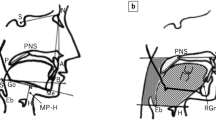Abstract
Determination of obstructive site in obstructive sleep apnoea (OSA) is of paramount importance is planning the management. Cephalometric evaluation of lateral X-rays when combined with clinical assessment and fibreoptic examination of the airway helps in locating the site of obstruction. The usual technique of cephalometry has been modified so as to give a better delineation of the soft tissues. Holding a 2mm card board in the mouth and using barium paste helped in more accurate calculations. Using our technique, various parameters have been quantified and a number of controls were studied and normal range derived. Further improvement in cephalometry has been done by using C.T. cephlometry topogram technique. A topogram is a scan done on a running table top cranio-caudally. Using the topogram technique 38 OSA patients were evaluated for all the parameters. The technique, its advantages over traditional cephalometry and the values obtained in the study are discussed in this paper.
Similar content being viewed by others
References
Borowiok BD, Kukwa A, Blanks and Irvine RH. Cephalometric analysis for diagnosis and treatment of obstructive sleep apnoea. Laryngoscope 1998;98:226–34.
Launois SH, Feroah TR. Site of pharyngeal narrowing predicts outcome of surgery for obstructive sleep apnoea. Am Rev Respinator Dis 1993;147:182–9.
Reily RW, Powell NB, Guilleminault C. Obstructive sleep aonoea syndrome: Surgical protocol for dynamic upper airway reconstruction. J Oral Maxillo Facial Surg 1993;51:742–7.
Cutellari S, Oizinaolo C, et al. Cephalometry and digital radiographs technical note. Radiologic Med 1993;86:899–903.
Yildrin N, Fitzpatrick MF, et al. The effect of posture on upper airway dimensions in normal subjects and in patients with sleep aonoea. Am Rev Respirator Dis 1991;144:845–7.
Rao JJ, Kumar V. Determination of obstructive site in obstructive sleep apnoea. Indian J Otolaryngol Head Neck Surg 1993;2:50–6.
Maltair F, Carier G, Cormier Y, Series F. Cephalometric measurements in snorers, non-snorers and patients with sleep apnoea. Thorax 1911;465:419–23.
Redline S, et al. Racial differences in sleep disordered breathing in African—Americans and caucasions. Am J Respir Crit Care Med 1977;155:186–92.
Guilleminault R, Powell N. Palatopharyngoplasty failure, cephalometric roentgrams and obstructrive sleep apnoea. Otolaryngol Head Neck Surg 1984;93:240–3.
Author information
Authors and Affiliations
Rights and permissions
About this article
Cite this article
Rao, J.J., Kumar, V.E., Chowdary, S.V. et al. CT-Cephalometry—A study in Indian population. Indian J Otolaryngol Head Neck Surg 57, 30–34 (2005). https://doi.org/10.1007/BF02907623
Issue Date:
DOI: https://doi.org/10.1007/BF02907623




